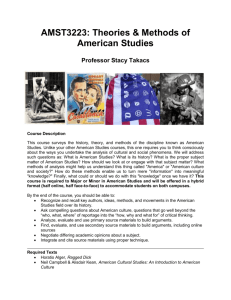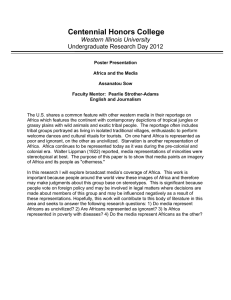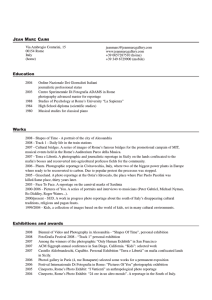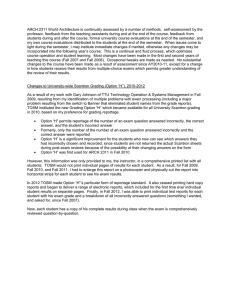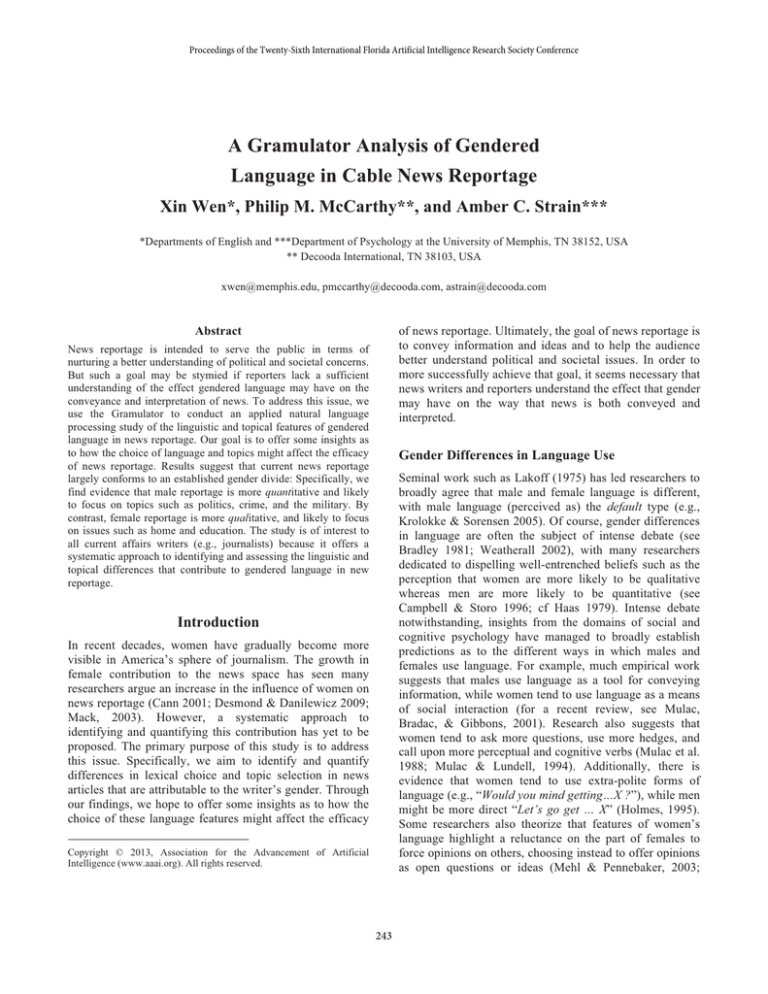
Proceedings of the Twenty-Sixth International Florida Artificial Intelligence Research Society Conference
A Gramulator Analysis of Gendered
Language in Cable News Reportage
Xin Wen*, Philip M. McCarthy**, and Amber C. Strain***
*Departments of English and ***Department of Psychology at the University of Memphis, TN 38152, USA
** Decooda International, TN 38103, USA
xwen@memphis.edu, pmccarthy@decooda.com, astrain@decooda.com
of news reportage. Ultimately, the goal of news reportage is
to convey information and ideas and to help the audience
better understand political and societal issues. In order to
more successfully achieve that goal, it seems necessary that
news writers and reporters understand the effect that gender
may have on the way that news is both conveyed and
interpreted.
Abstract
News reportage is intended to serve the public in terms of
nurturing a better understanding of political and societal concerns.
But such a goal may be stymied if reporters lack a sufficient
understanding of the effect gendered language may have on the
conveyance and interpretation of news. To address this issue, we
use the Gramulator to conduct an applied natural language
processing study of the linguistic and topical features of gendered
language in news reportage. Our goal is to offer some insights as
to how the choice of language and topics might affect the efficacy
of news reportage. Results suggest that current news reportage
largely conforms to an established gender divide: Specifically, we
find evidence that male reportage is more quantitative and likely
to focus on topics such as politics, crime, and the military. By
contrast, female reportage is more qualitative, and likely to focus
on issues such as home and education. The study is of interest to
all current affairs writers (e.g., journalists) because it offers a
systematic approach to identifying and assessing the linguistic and
topical differences that contribute to gendered language in new
reportage.
Gender Differences in Language Use
Seminal work such as Lakoff (1975) has led researchers to
broadly agree that male and female language is different,
with male language (perceived as) the default type (e.g.,
Krolokke & Sorensen 2005). Of course, gender differences
in language are often the subject of intense debate (see
Bradley 1981; Weatherall 2002), with many researchers
dedicated to dispelling well-entrenched beliefs such as the
perception that women are more likely to be qualitative
whereas men are more likely to be quantitative (see
Campbell & Storo 1996; cf Haas 1979). Intense debate
notwithstanding, insights from the domains of social and
cognitive psychology have managed to broadly establish
predictions as to the different ways in which males and
females use language. For example, much empirical work
suggests that males use language as a tool for conveying
information, while women tend to use language as a means
of social interaction (for a recent review, see Mulac,
Bradac, & Gibbons, 2001). Research also suggests that
women tend to ask more questions, use more hedges, and
call upon more perceptual and cognitive verbs (Mulac et al.
1988; Mulac & Lundell, 1994). Additionally, there is
evidence that women tend to use extra-polite forms of
language (e.g., “Would you mind getting…X ?”), while men
might be more direct “Let’s go get … X” (Holmes, 1995).
Some researchers also theorize that features of women’s
language highlight a reluctance on the part of females to
force opinions on others, choosing instead to offer opinions
as open questions or ideas (Mehl & Pennebaker, 2003;
Introduction
In recent decades, women have gradually become more
visible in America’s sphere of journalism. The growth in
female contribution to the news space has seen many
researchers argue an increase in the influence of women on
news reportage (Cann 2001; Desmond & Danilewicz 2009;
Mack, 2003). However, a systematic approach to
identifying and quantifying this contribution has yet to be
proposed. The primary purpose of this study is to address
this issue. Specifically, we aim to identify and quantify
differences in lexical choice and topic selection in news
articles that are attributable to the writer’s gender. Through
our findings, we hope to offer some insights as to how the
choice of these language features might affect the efficacy
Copyright © 2013, Association for the Advancement of Artificial
Intelligence (www.aaai.org). All rights reserved.
243
Mulac, Bradac, & Gibbons, 2001; cf. Thomson &
Murachver, 2001).
There is some evidence that women are more likely than
men to use emotion terminology in their language (Mulac
et al., 1990). However, more recent research suggests that
men and women are somewhat equivalent in their use of
emotion words, but differ in the types of emotion words
they use. In general, there is evidence that women tend to
talk more about positive emotions like happiness or joy,
while men are more likely to talk about negative emotions
like anger (Mehl & Pennebaker, 2003).
In sum, from the time of Haas (1979), research into
gendered language provides evidence that male language is
more direct, more likely to have physical topics, more
likely to include quantifiable elements (e.g., sports, money,
business, time) and more likely to feature destructive
aspects (e.g., military matters). By contrast, female
language is more likely to be supportive and polite, more
likely to include elements of home and family, and more
likely to be evaluative. Given this breadth of findings, it is
reasonable to assume that gendered language extends into
news reportage.
Taken as a whole, this study builds on a tradition of
assessing gender differences of news topics but fills a gap
in the literature by focusing on the linguistic features that
may be indicative of gender. Specifically, we investigate
news reportage so as to address the following primary
research question: Does a computational analysis at the
linguistic level reveal topic differences between male and
female news reportage? We further ask, What specific
topics are revealed by this analysis? To address our
research questions, we formed the hypothesis that the
language of male and female news reporters will have
lexical differences which reflect established topic
difference within news media (see Cann, 2001; Desmood &
Danilevizs, 2009; Soderlund et al, 1989). For instance, we
predicted that males would be more likely to feature
“harder” topics (e.g. politics and crime) and females would
be more likely to feature “softer topics (e.g., human
interest, health and home (see also Armstrong, Boyle and
McLeod, 2012).
Corpora
Our corpus comprises 142 online news texts taken from
FOX News and MSNBC. The corpus was divided into
Male (n = 82) and Female (n = 60) categories based on the
reporter’s name and author-identified websites. Fox and
MSNBC were selected for text collection because they are
two of the major leading news cable networks. The two
channels are also appropriate as they represent,
respectively, what is widely perceived as the right and left
wing manifestation of American cable news (Groeling
2008). The texts were all extracted over a two-week period
from September 20, 2012 to October 4, 2012. Although
larger and well-establish databases are available, current
news stories were selected so that contemporary issues
would be the focus. All texts were selected from the “U.S.
news section” of the respective websites. To better
establish confidence in the primary variables (i.e. Male and
Female), the editors of the news websites were consulted
for information concerning the writers’ contribution to the
final text. In terms of age, all reporters were described as
ranging from 30-40 years old. In terms of editing practices,
the editors for both networks reported that they were in
charge of such issues as correcting errors in spelling,
grammar, and punctuation as well as errors in facts and in
formatting. The editors reported that if the writers’ name
appears in the by-line, it means that the news article was
overwhelmingly written by that person. Given the
exploratory nature of this initial investigation, the corpus of
texts would appear to be a reasonable point of departure for
a representation of gendered language features of news
articles.
Gendered Differences in News Reportage
Considerable research in gendered language has been
conducted in news reportage (e.g., Desmond & Danilewicz,
2009; 2009; Grabe & Kamhawi, 2006). One of the earliest
examples is Soderlund et al. (1989) who conducted a
content analysis of television news in Canada. Soderlund
and colleagues revealed that female reportage appeared to
be “softer” and more general than that of their male
counterparts. More recently, Desmond and Danilewicz
(2009) examined local news and found that female
reporters were more likely to present human interest and
health related stories, whereas male reporters tended to
present political stories.
Although the concept of gender in news reporting has
been explored for more than three decades, the majority of
studies have focused on reportage at the topic level, rather
than the lexical level. This is not to say that analysis of
news reporting at the lexical level is rare. For example,
O’Donnell and Todd (1980) compared prominent linguistic
features of major British newspapers; and Ljung (1997)
also used newspapers to assess the use of modals, relative
pronouns, and sentence complexity. More recently, Haertl
and McCarthy (2012) made a considerable development in
lexical analysis of news reportage with their introduction of
systematic computational corpus analysis. Specifically, the
authors assessed news websites and demonstrated
quantifiable differences in the lexical features between
northern US border and southern US border local news
reportage. Although clearly there is a history of lexical
analysis of news reportage, to our knowledge there are no
contemporary studies that explore the lexical underpinnings
of gender in the news.
The Gramulator
In this study, we use the textual analysis system, the
Gramulator (McCarthy, Watanabe, & Lamkin, 2012). The
244
Gramulator identifies key linguistic features within a
contrastive corpus design. Specifically, in this study, the
contrastive design is the identification of relative indicative
lexical and topical features of Male reportage and Female
reportage.
The Gramulator uses n-gram analysis to identify strings
of indicative lexical features of one corpus relative to
another. The major unit of Gramulator analysis is the
differential bi-gram (or D-bigram). This unit is the most
commonly employed across Gramulator studies (Min &
McCarthy 2010; Stanchevici, in press; and for an extensive
review, see Booker 2012).
Indices are created based on a procedure of machine
differential diagnostics (MDD; McCarthy, Watanabe, &
Lamkin, 2012). MDD allows for meaningful lexical
features of a representative corpus to be identified through
a process of relativity. The principle is that any discourse
unit (e.g. a corpus of Male reportage) is best understood in
the context of its contrastive corpus (i.e., Female
reportage). The Gramulator’s MDD process is established
through the following major steps: 1) Calculate the
weighted frequency of the designated lexical unit; and 2)
Eliminate from consideration any lexical units that are
characteristics of both corpora. In Step 1, designated lexical
units (here, bigrams) are weighted according to their gross
frequency across the corpus relative to their binary
occurrence in documents. The final evaluation also
considers the length of the document in which the lexical
unit occurs (see McCarthy, Watanabe, & Lamkin 2012 for
full details). In Step 2, designated lexical units (e.g.,
bigrams) that pass a threshold weigh of “high frequency” in
both corpora are removed. The principle here is that what is
characteristic of both corpora is indicative of neither. The
bigrams that remain are therefore high frequency
characteristics of only one of the contrastive corpora. These
bigrams are deemed indicative and, collectively, they form
the index designated for each category. Thus, in
Gramulator nomenclature, D-bigrams: Male (Female)
means an index of bigrams that are high frequency in the
Male corpus but not high frequency (although may be
present) in the Female corpus.
In recent years, the Gramulator has featured in many
studies of contrastive corpora across a variety of contexts
(Min & McCarthy 2010; Stanchevici, in press; see Booker,
2012 for an extensive review). This widespread and
successful application of the Gramulator suggests it is a
suitable tool for the current analysis.
established corpus validity, the main Gramulator module
processed the two corpora (Male and Female) to identify
D-bigrams for Male (Female) and Female (Male). The
analysis of the validation and the D-bigram assessment is
detailed over the following sections.
Corpus Validation
Corpus validation is a critical element for demonstrating
confidence in the distribution of collected data when
conducting computational textual analysis approaches
(McCarthy, Duran, & Booker, 2011). To establish this
confidence, we used the internal validation process (IVP;
Booker, 2012). The IVP is an assessment procedure
devised for analyses that involve evaluated data and
evaluating indices. For the Gramulator, the IVP is
conducted as follows: 1) Randomly divide the data into
training and test sets; 2) Use the training set data to form
indices following the MDD procedure explained earlier; 3)
Assess the test set data using the differentials that form the
indices; 4) The derived indices (from the training data)
together with the test set data make possible a series of six
means tests (see below). If all six means are in the
predicted direction then binomial probability suggests
significance at the level of p < .05. Note that it is the
accumulated effect of six means tests that is critical here
rather than a t-test on any one (or more) comparisons.
The predicted directions, associated hypothesis, and
results of the IVP are given below. Note that in Gramulator
nomenclature, an analysis such as Md # Mi > Md # Fi can
be read as follows: the Male data set (Md), which is the test
set data, as measured by (#) the Male index (Mi), which
comprises the differentials derived from the male training
set data, will produce a descriptive value greater than (>)
the same Male data set (Md) as measured by (#) the Female
index, which comprises the differentials derived from the
corresponding female training set data.
1. Md # Mi > Md # Fi. Male data will provide higher
values when using the Male index than when using the
Female index. The Male index will produce higher values
for the Male data if the differentials of the index that were
produced from the Male training set are more consistent
with the Male data than the corresponding differentials of
the Female training set. The result supported the prediction
(Male by Male: M = 25.21, SD = 16.23; Male by Female:
M = 21.02; SD = 12.20).
2. Fd # Fi > Fd # Mi. Female data will provide higher
values when using the Female index than when using the
Male index. The Female index will produce higher values
for the Male data if the differentials of the index that were
produced from the female training set are more consistent
with the Male data than the corresponding differentials of
the male training set. The result supported the prediction
(Female by Female: M = 25.01, SD = 20.79; Female by
Male: M = 24.27; SD = 12.20).
Results
The corpora of Male and Female reportage were processed
following standard Gramulator procedures (see Booker,
2012; McCarthy, Watanabe, & Lamkin, 2012). Thus, the
corpus was first validated to establish confidence in its
representation of the designated categories. Having
245
3. Fd # Fi > Md # Fi. Female data will provide higher
values when using the Female index than Male data when
using the same index. The Female data will produce higher
values from the Female index if the differentials from the
Female index are more consistent with the Female data
than they are with the Male data. The result supported the
prediction (Female by Female: M = 25.01, SD = 20.79;
Male by Female: M = 21.02; SD = 25.42).
4. Md # Mi > Fd # Mi. Male data will provide higher
values when using the Male index than Female data when
using the same index. The Male data will produce higher
values from the Male index if the differentials from the
Male index are more consistent with the Male data than
they are with the Female data. The result supported the
prediction (Male by Male: M = 25.21, SD = 16.23; Female
by Male: M = 24.27; SD = 12.20).
5. Md # Mi > Fd # Fi. Male data will provide higher
values when using the corresponding Male index than
Female data when using the corresponding female index.
The Male # Male assessment will produce higher values
than the Female # Female assessment if the Male data and
index are more consistent than the Female index and data.
Here, greater consistency implies the default whereas the
alternative form would likely be more diverse and
correspondingly lead to lower consistency between
evaluating index and evaluated test data. The result
supported the prediction (Male by Male: M = 25.21, SD =
16.23; Female by Female: M = 25.01; SD = 20.79).
6. Fd # Mi > Md # Fi. Female data will provide higher
values when using the Male index than Male data when
using the Female index. The Female data will produce
higher values from the Male index than the Male data from
the Female index if the Male index is the more consistent.
Here, greater consistency implies the default whereas the
alternative form would likely be more diverse and
correspondingly lead to lower consistency between trained
index and test data. The index, being more concentrated
than the data, would favor the default Male over the
alternative Female. The result supported the prediction
(Female by Male: M = 24.27, SD = 12.20; Male by Female:
M = 21.02; SD = 25.42).
deployment between the two genders. Our analysis
revealed three dyads: (1) Male-investigators vs. Femaleprosecutors, (2) Male-State vs. Female-Home/Education,
and (3) Male-quantitative vs. Female-qualitative. The
results of these dyads are given below. Note that in
Gramulator nomenclature, a result such as (Male: 96,
30/82; Female: 20, 12/60; p = .041) can be read as Males
produced 96 total instances of the construct (i.e., the
collected examples of D-bigrams that matched the theme),
occurring in 30 of the 82 total files; whereas Females
produced 20 total instances, occurring in 12 of their 60
total files; a Fisher’s Exact Test suggests this difference to
be significant (p = .041).
Male-Investigators vs. Female-Prosecutors
A distinction between the theme of Male-investigators and
Female-prosecutors supports research such as Armstrong,
Boyle and McLeod (2012) and Desmond and Danilewicz
(2009). That research suggests that men are more likely to
report on intense, dynamic, active stories, whereas women
are more likely to report on safer aspects in a more
controlled environment. The result features 6 D-bigrams for
investigators and 8 D-bigrams for prosecutors. Males
appear to be significantly more likely to use investigator
features than females (Male: 96, 30/82; Female: 20, 12/60;
p = .041). Conversely, females appear to be significantly
more likely to use prosecutor features than males (Female:
84, 19/60; Male: 36, 14/82; p = .047). The Maleinvestigators element included D-bigrams such as police
said, law enforcement, charged with, homeland security,
the bill, the investigation. By contrast, the Femaleprosecutors element included D-bigrams such as supreme
court, same sex marriage, the court, convicted of, a judge,
gay marriage, in court, sexual assault (see Table 1 for
concordance examples).
Male-State vs. Female-Home/Education
A distinction between the theme of Male-State and FemaleHome/Education supports research such as Cann (2001),
Desmond and Danilewicz (2009), and Soderlund et al.
(1989). The research suggests that men are more likely to
report on “harder” topics (e.g., politics, world affairs, and
conflict), and women on “softer” topics (e.g., health and
human interest). The result features 20 D-bigrams for state
and 5 D-bigrams for home/education. Males appear to be
significantly more likely to use state features than females
(Male: 129, 26/82; Female: 20, 9/60; p = .030). Conversely,
females appear to be more likely to use home/education
features than males (Female: 52, 21/60; Male: 9, 8/82; p
<.001). The Male-state element included D-bigrams such as
the election, barack obama, the federal, the senate, white
house, the military, and the president. By contrast, the
Females-home/education element included D-bigrams such
as the family, the woman, a child, the couple, public school,
and the students (see Table 1 for concordance examples)
D-bigram Analysis of Topics
The Gramulator’s Viewer module displays the derived Dbigrams relevant to the study: Male (Female) and Female
(Male). These D-bigrams are manually sorted into themes
in a manner not unlike naming factors in a principle
components analysis. To establish initial confidence in the
manual sorting process, three criteria need to be satisfied:
(1) Themes need adhere to the theoretical gender construct
described earlier; (2) Themes must form a dyad, such that
both the Male and Female theorized element is present; and
(3) there must be a significant difference in the D-bigram
246
Table 1: Concordance examples of Male/Female categories for the three identified dyads
Dyad
Gender
Male
Investigators/
Prosecutors
Female
Male
State/
Home &
Education
Female
Male
Quantitative/
Qualitative
Female
Corpus Examples
jumped approximately 20 feet into the den, police said before rescuers could reach the man
terrorist experts like sam kharoba to help law enforcement agencies to route [sic] out radical
same-sex couples wait for the supreme court to decide if it will hear one of five challenges
the supreme court decide the question of same-sex marriage
white house risks complaints that president barack obama is anti-business from republicans
the military and veterans vote could tip the election, iava is armed with the sorts of stats that
a state of anguish.the family has been broken in half by this tragedy
debate nationwide over how to improve public schools. democrats and republicans have blasted
toyota priuses has travelled hundreds of thousands of miles in northern california where
passwords were leaked online. soon after, millions of passwords from eHarmony and yahoo
the country looking for who was doing the best work and we found the ounce of prevention
encouraged by polls showing they have a good chance of finally logging their first victory
current study has limitations: Future research needs to
increase corpus size, include international news, and
examine gender across a wide variety of news domains.
Additionally, we need to examine linguistic features across
gender when the same topics occur. It is also possible that
topics could differ depending on the source (e.g., Fox News
only). Future research also needs to consider other
approaches to topic extraction such as Latent Direchlet
Allocation Blei, Ng, & Jordan 2003) approach).
Despite these limitations, our study is of interest to
anyone (especially writers) whose task is to effectively
communicate information. Our study is of particular
interest to journalist, editors, and current affairs
communicators (e.g., bloggers) because it highlights how
gendered linguistic and topical differences (unconsciously)
permeate reportage. The study is also of importance to
linguists and cognitive psychologist because it stands to
better identify textual features of gendered language. Such
insights may facilitate predictions regarding male and
female communication, understanding, and perception.
Even with broad agreement that differences exists, the
study of gendered language remains fraught with intense
debate. The systematic identifying and assessment of these
differences through computational, textual analysis is
unlikely to end the debate but it may, at least, provide
enough useful information for new and productive
discussions to develop.
Male-Quantitative vs. Female-Qualitative
A distinction between the theme of Male-quantitative and
Female-qualitative supports Mulac, Bradac, and Gibbons
(2001) and Hass (1979). That research suggests that men
are more likely to favor quantitative language elements
(e.g., sports, money, business, and time) whereas women
are more likely to favor qualitative elements (e.g.,
politeness, expressive language, issues of home, family,
feeling, and interpretation). The result features 10 DBigrams for quantitative and 3 D-bigrams for qualitative.
Males appear to be significantly more likely to use
quantitative features than females (Male: 100, 39/82;
Female: 28, 17/60; p = .024). Conversely, females appear
to be significantly more likely to use qualitative features
than males (Female: 22, 16/60; Male: 7, 7/82; p = .005).
The Male-Quantitative element included D-bigrams such as
hundreds of, thousands of, millions of, dozens of, lot of,
most of, a few. By contrast, the Females-Qualitative
element included D-bigrams such as the best and a good.
(see Table 1 for concordance examples).
Conclusions and Discussion
This study used the Gramulator to investigate the linguistic
and topical features of male and female news reportage.
Our analysis revealed evidence of gendered differences that
broadly conform to an established gender divide. We found
evidence that male reportage is more likely to focus on
topics such as politics, crime, and the military; whereas,
female reportage focused on issues such as home and
education. We also reported evidence for a Male
quantitative linguistic element and a Female qualitative
element.
Although we provide compelling and extensive evidence
for the validity of the corpus, we acknowledge that the
References
Armstrong, C.L., Boyle, M.P., Mcleod, D.M. 2012. A
global trend: How news coverage of protests reinforces
gender stereotypes. Journalism Studies. 13(4), 633-648.
Blei, D. Ng, A. and Jordan. M. 2003. Latent Dirichlet
allocation. Journal of Machine Learning Research, 3, 993–
1022.
247
Booker, L. M. 2012. When worldviews collide: What
linguistic style matching and distal language reveal about
deception in political discourse. (Doctoral dissertation).
The University of Memphis, TN.
Bradley, P. H. 1981. The folk linguistics of women’s
speech: An empirical examination. Communication
Monographs, 48, 73–90.
Campbell, P.B., and Storo, J. N. 1996. Math and Science
for the Coed Classroom: Girls Are…Boys Are… Myths,
Stereotypes, and Gender Differences. Newton: WEAA
Publishing Center.
Cann, D. 2001 Journalist and source gender in Australian
television news. Journal of Broadcasting & Electronic
Media, 45, 162-185.
Desmond, R. and Danilewicz, A. 2009. Woman Are on,
But Not in, the News: Gender Roles in Local Television
News. Sex Roles, 62, 822-829.
Grade, M.E. and Kamhawi, R. 2006. Hard wired for
negative news? Gender differences in processing broadcast
news. Communication Research. 33(5), 346-369.
Groeling, T. 2008. Who’s the fairest of the all? An
empirical test for partisan bias on ABC, CBS, NBC, and
Fox News. Presidential Studies Quarterly, 38(4), 631-657.
Haas, A. 1979. Male and female spoken language
differences: Stereotypes and evidence. Psychological
Bulletin, 86(3), 616-626.
Haertl, B. E., and McCarthy, P.M. 2011. Differential
Linguistic Features in US Immigration Newspaper Articles:
A Contrastive Corpus Analysis Using the Gramulator.
Proceeding of the 24th International Florida Artificial
Intelligence Research Society Conference. Menlo Park,
CA: The AAAI Press.
Holmes, J. 1995. Women, men and politeness. Harlow:
Longman.
Krolokke, C., and Sorensen A.S. 2005. Gender
Communication Theories and Analyses: From Silence to
Performance. Sage Publication, INC: New Delhi, India. 4:
68.
Lakoff, R. 1975. Language and woman’s place. New York:
Harper Colophon Books.
Ljung, M. 1997. Corpus-based studies in English: papers
from the seventeenth international conference on English
language research on computerized corpora(ICAME 17)
Stockholm, May 15-19, 1996. Amsterdam: Atlanta, GA :
Rodopi.
Mack, C. 2003. Ann Curry: Living the Dream. Flash, 18, 13.
Mehl, M.R., and Pennebaker, J.W. 2003. The sounds of
social life: A psychometric analysis of students’ daily
social environments and natural conversations. Journal of
Personality & Social Psychology, 84, 857–870.
McCarthy, P.M., Duran, N. D., and Booker, L.M. 2012.
The Devil’s in the Details: New Directions in Deception
Analysis. Invited paper in P.M. McCarthy and G.M.
Youngblood (Eds.), Proceedings of the 25th International
Florida Artificial Intelligence Research Society Conference
(pp. 188-195). Menlo Park, CA: The AAAI Press.
McCarthy, P.M.; Watanabe S. and Lamkin, T.A. 2012. The
Gramulator: A tool for the identification of indicative
linguistic features. In P.M. McCarthy and C. Boonthum
(Eds.), Applied Natural Language Processing and Contend
Analysis: Identification, Investigation, and Resolution.
Hershey, PA: IGI Global.
Min, H.C. and McCarthy, P.M. 2010. Identifying varietals
in the discourse of American and Korean scientists: A
contrastive corpus analysis using the Gramulator. In H.W.
Guesgen & C. Murray (Eds.), Proceeding of the 2rd
International Florida Artificial Intelligence Research
Society Conference. Menlo Park, CA: the AAAI Press,
247-252.
Mulac, A., Bradac, J.J., and Gibbons, P. 2001. Empirical
support for the gender-as-culture hypothesis: An
intercultural analysis of male/female language differences.
Human Communication Research, 27, 121–152.
Mulac, A., and Lundell, T.L. 1994. Effects of genderlinked language differences in adults’ written discourse:
Multivariate tests of language effects. Language &
Communication, 14, 299–309.
Mulac, A., Studley, L.B., and Blau, S. 1990. The genderlinked effect in primary and secondary students’
impromptu essays. Sex Roles, 23, 439–469
Mulac, A., Wiemann, J. M., Widenmann, S. J., and Gibson,
T.W. 1988. Male/female language differences and effects
in same-sex and mixed-sex dyads: The gender-linked
language effect. Communication Monographs, 55, 315–
335.
O’Donnell, R.W and Todd. L. 1989. Variety in
contemporary English. London: Routledge.
Soderlund, S., Surline, S., and Romanow, W. 1989. Gender
in Canadian local television news: Anchors and reporters.
Journal of Broadcasting & Electronic Media, 33, 187-196.
Stanchevici D. in press. The rhetorical construction of
social classes in the reports of Stalin's secret police. Journal
of Technical Writing and Communication.
Thomson, R., and Murachver, T. 2001. Predicting gender
from electronic discourse. British Journal of Social
Psychology, 40, 193–208.
Weatherall, A. 2002. Gender, language, and discourse.
London: Routledge
.
248

